November is Native American Indian Heritage Month, and communities across America are celebrating the many contributions of American Indians and Alaska Natives to our nation. The theme of this year’s observance is “Honoring our Nations: Building Strength Through Understanding,” commemorating the national sovereignty and military service of America’s First Peoples.
Joseph Quintana (Kewa Pueblo), UAII Director of Development and Mayoral Appointee to the Los Angeles City/County Native American Indian Commission, was invited as the distinguished Guest of Honor to the U.S. Army Corps of Engineers Native American Indian Heritage Month Observance event, which took place on Wednesday, November 6. During his keynote address, Quintana set the stage for a continued partnership between the U.S. Army Corp and UAII.
“We don’t always hear from Native people,” he said. “But to able to come out and present to the U.S. Army Corps of Engineers – and I’m just one voice – being able to speak on behalf of the community I serve, I hope this will become a continued dialogue.”
Quintana relayed his own personal story growing up a ‘dual-citizen’ of Kewa Pueblo and Los Angeles. “It’s important to understand the complex nature of tribal sovereignty,” he said. “Once a young American Indian is born here, we have an opportunity for immediate dual-citizenship. We are citizens of the United States, and we also have the opportunity to be citizens of our Tribal Nation. I am currently a citizen of the United States and a citizen of Kewa Pueblo.”
He went on to describe little-known facts about Kewa Pueblo. “Archeologists have shown that our culture has a footprint dating approximately 6000 years,” he said. “Some of the largest multi-level manmade structures in the southwest were created by Pueblo culture, dating between 100 AD and 1600 AD. We still have high rates of culture and language retention. Over 90% of our current community still speaks and retains their language. But that richness of cultural identity has come with losses and big gaps, including poverty. The majority of the current population in our village are without jobs, without continuous employment, we still have dirt roads, and the majority of our homes are built out of adobe bricks.”
Quintana spoke about his late grandmother, a long-time Los Angeles County probation officer who came to Los Angeles during the 1956 Relocation Program. “United States policy for American Indians has had a difficult past,” he said. “My grandmother went through the boarding school system. She was not allowed to speak her language. As of the 1880s, there were over 100 federal boarding schools across the country – the majority of which were military installations that had been converted into boarding schools. Once they left their reservation and went to boarding school, they became a shell of the person they were. They were strangers to the community they left, including their parents. ”
He described his grandmother’s relocation to Los Angeles. “In 1956, the government came up with the Relocation Act,” he explained. “My grandmother graduated from Haskell Institute in Lawrence, Kansas, and they said to her, ‘Do you want to go home to Oklahoma, to a one-room shack with no running water with twelve other people living in it? Or, do you want to pursue something greater?’ She took the latter and came to Los Angeles. But the majority of funding for that program ran out, and some of our folks ended up on the streets, succumbing to substance abuse or worse.”
“The Relocation Program formally ended in 1969,” he continued. “1975 began the Self Determination Period when American Indians were free to pursue business opportunities and develop their communities on their own, without the Bureau of Indian Affairs. From 1978 until the present day, we’ve been given the legal right to freely practice our religion. And in 1978, we established the Indian Child Welfare Act. Currently, in LA County, there are over 150 American Indian children in the foster care system. There is only one American Indian foster family. Imagine what is being lost within the cultural identity of that young person.”
Quintana spoke about his late grandfather, a United States serviceman who participated in WWII as part of a tank destroyer battalion. “He grew up his entire life in Kewa Pueblo,” he said. “And he only knew Keris, our traditional language, until he was 16. Then, he went off to boarding school, and then the military. After the military, he came home and worked for the railroad until his retirement. The railroad took him all over the country and to Los Angeles, where he met my grandmother. These are the two people that were instrumental in my life; two people that I look up to even to this day. But there were times when we were very close to being homeless.”
After graduating with a master’s degree from the University of Arizona, Quintana didn’t want to come back to Los Angeles. “There were too many negative memories here,” he said. “The smell of alcohol; the grumbling of my stomach; going to sleep hungry because I didn’t know where my next meal would come from. But eventually, within the American Indian perspective, everything is cyclical. You have to come back at some point. And I did.”
Quintana described the founding of UAII in 1974. “UAII grew from a couple of employees and a couple hundred thousand dollars to a couple of hundred employees and a multi-million dollar budget,” he said. “We’re over $10 million now, which is the highest in our over 45-year history. Tremendous growth.”
Deputy Commander Col. Daryll F. Fust presented Quintana with an official Certificate of Appreciation from Los Angeles U.S. Army Corps District Commander, Col. Aaron Barta.
“It’s important that we should honor Native Americans and their significant contributions to our culture,” said Fust. “I come from the Arizona area. Amongst our entire district, there are 64 tribal partners that we work within the course of a year. I was relating to our Guest of Honor that I remember when Lori Ann Piestewa was honored and they renamed a peak in Arizona in her name, which I think was an honor befitting her sacrifice for this great nation.”
Squaw Peak was renamed Piestewa Peak in 2003 after soldier Lori Piestewa (Hopi) was killed in combat.
Steve Weiss, program manager for the U.S. Army Corp American Indian/Alaskan Native Special Emphasis Program, brought his own personal collection of Native American memorabilia to the event for display, which included Navajo pots, a totem pole from Alaska, blankets loaned from the Lakota Indian tribe in Montana, a dream catcher made by a tribe in South Dakota, pictures taken in Albuquerque, New Mexico, as well as books, pictures, and information from tribes around the nation.
“This year’s theme, ‘Honoring our Nations: Building Strength Through Understanding,’ highlights the various aspects of the 567 federally recognized tribes, each with their own rich and beautiful cultural background,” explained Weiss. “We honor present American Indian and Alaska Native servicemembers from all branches of military service. Their contributions have been critical to our national defense.”
More than 9,000 American Indians and Alaska Natives currently serve in the U.S. Army as active-duty Soldiers, National Guardspersons, and in the Army Reserve.
“Addressing new audiences and educating the Native and non-Native public about the American Indian community we serve benefits UAII long-term,” said Quintana. “These opportunities can be important for starting long-lasting relationships that positively impact Native people in Los Angeles and across the country. I was honored to have been chosen as a keynote speaker at the U.S. Army Corp of Engineers, and it was a tremendous first step in our partnership. This experience gave me a deeper appreciation for the American Indian presence and sacrifice in the United States military.”
The U.S. Army Corps of Engineers
The U.S. Army Corps of Engineers Los Angeles District provides civil works and military engineering support to Southern California, Nevada, Arizona, and parts of Utah. The area encompasses 226,000 square miles, 420 miles of coastline, 14 harbors, and the highest, lowest, and hottest spots in the contiguous 48 states. The scope of missions in the district varies from supporting the world’s largest groundwater recharge system in Orange County, to involvement in one of the nation’s most significant transportation projects, the California High-Speed Rail.













